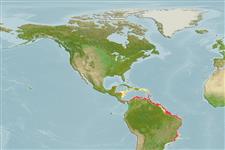>
Scombriformes (Mackerels) >
Scombridae (Mackerels, tunas, bonitos) > Scombrinae
Etymology: Scomberomorus: Latin, scomber = mackerel + Greek, moros = silly, stupid (Ref. 45335).
Environment: milieu / climate zone / depth range / distribution range
Ecología
marino asociado a arrecife; oceanodromo (Ref. 51243). Tropical; 21°N - 36°S, 90°W - 29°W (Ref. 168)
Western Atlantic: along the Caribbean and Atlantic coasts of Central and South America from Belize to Rio Grande do Sul, Brazil. Literature records for Scomberomorus maculatus from the Caribbean and the Atlantic coasts of Central and South America apply to Scomberomorus brasiliensis, which has erroneously been considered a synonym of Scomberomorus maculatus by many authors.
Length at first maturity / Tamaño / Peso / Age
Maturity: Lm 37.0 range ? - ? cm
Max length : 125 cm FL macho / no sexado; (Ref. 168); common length : 65.0 cm TL macho / no sexado; (Ref. 9987); peso máximo publicado: 6.7 kg (Ref. 40637)
Espinas dorsales (total): 17 - 19; Radios blandos dorsales (total): 15-19; Espinas anales 2; Radios blandos anales: 16 - 20; Vértebra: 47 - 49. Snout much shorter than rest of the head. Interpelvic process short and bifid. Lateral line gradually curving down toward caudal peduncle. Body entirely covered with small scales, no anterior corselet developed. Pelvic fins relatively short. Intestine with 2 folds and 3 limbs. Swim bladder absent. Sides silvery with several rows of round yellowish bronze spots. First dorsal fin black.
Does not migrate extensively, although some seasonal movement appears to occur off Trinidad. Feeds largely on fishes, with smaller quantities of penaeid shrimps and loliginid cephalopods. Most of the catch is consumed fresh, but in Brazil some is salted and some has been canned. Also utilized smoked and frozen; used for ceviche (Ref. 9987).
Collette, B.B. and C.E. Nauen, 1983. FAO Species Catalogue. Vol. 2. Scombrids of the world. An annotated and illustrated catalogue of tunas, mackerels, bonitos and related species known to date. Rome: FAO. FAO Fish. Synop. 125(2):137 p. (Ref. 168)
IUCN Red List Status (Ref. 130435)
Threat to humans
Harmless
Human uses
Pesquerías: comercial; pesca deportiva: si
Más información
ColaboradoresImágenesStamps, Coins Misc.SonidosCiguateraVelocidadTipo de nataciónSuperficie branquialOtolitosCerebrosVisión
Herramientas
Special reports
Download XML
Fuentes de Internet
Estimates based on models
Preferred temperature (Ref.
123201): 24.9 - 28, mean 27.5 °C (based on 176 cells).
Phylogenetic diversity index (Ref.
82804): PD
50 = 0.5000 [Uniqueness, from 0.5 = low to 2.0 = high].
Bayesian length-weight: a=0.00776 (0.00472 - 0.01275), b=2.96 (2.82 - 3.10), in cm total length, based on LWR estimates for this species & Genus-body shape (Ref.
93245).
Nivel trófico (Ref.
69278): 3.3 ±0.4 se; based on diet studies.
Resiliencia (Ref.
120179): Medio, población duplicada en un tiempo mínimo de 1.4-4.4 años (K=0.18; tm=3-4).
Prior r = 0.56, 95% CL = 0.37 - 0.84, Based on 2 stock assessments.
Fishing Vulnerability (Ref.
59153): High to very high vulnerability (67 of 100).
Climate Vulnerability (Ref.
125649): High to very high vulnerability (75 of 100).
Nutrients (Ref.
124155): Calcium = 8.97 [3.62, 31.76] mg/100g; Iron = 0.344 [0.142, 0.904] mg/100g; Protein = 20.4 [18.8, 22.0] %; Omega3 = 0.117 [0.072, 0.195] g/100g; Selenium = 54.5 [16.0, 179.7] μg/100g; VitaminA = 77 [14, 433] μg/100g; Zinc = 0.793 [0.457, 1.403] mg/100g (wet weight); based on
nutrient studies.
